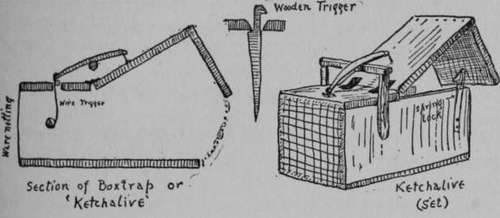Trapping Animals
Description
This section is from the book "The Book Of Woodcraft", by Ernest Thompson Seton. Also available from Amazon: The Book of Woodcraft.
Trapping Animals
Trapping wild animals with steel traps is a wretchedly cruel business and will doubtless be forbidden by law before long. The old-fashioned deadfall which kills the animal at once is quite sufficient for all the legitimate work of a trapper. But many boys wish to capture animals alive without doing them any injury, and this is easily managed for most species if a ketchalive is used. The ketchalive or old-fashioned box trap is made in a hundred different ways; but the main principles are shown in the illustration. The lock on the side is necessary for some species, such as skunks, that would easily lift the lid and escape.

For skunks, cats, weasels, mink, rats, etc., use a piece of chicken as bait.
For rabbits use bread, turnip, apple, or other vegetable.
The trap should be visited every morning or not used at all.
The Secrets Of The Trail
It was Fenimore Cooper who first put the good Indian on paper- who called the attention of the world to the wonderful woodcraft of these most wonderful savages.
It was he who made white men realize how far they had got away from the primitive. It was he who glorified the woodman and his craft. Yet nowhere do we find in Cooper's novels any attempt to take us out and show us this woodcraft. He is content to stand with us afar off and point it out as something to be worshiped - to point it out and let it die.
Fenimore Cooper has had many imitators, just as Uncas has had many successors. The fine art of trailing is still maintained in the Far West, and it has always seemed strange to me that none has endeavored to give it permanent record, other than superlative adjectives of outside praise.
Trailing
What is trailing? The fox-hunter has some idea when he sees a superb pack follow a faint scent through a hundred perplexing places, discerning just which way the fox went, and about how long ago. The detective does another kind of trailing when he follows some trifling clue through the world of thought, tracing the secret of an unknown man along an invisible path, running it to earth at last in the very brain that conceived it. In his trailing the Indian uses the senses of the "animal" to aid the brain of the man. To a great extent his eyes do the work of the hound's nose, but the nose is not idle. When the trail disappears, he must do the human detective work; but under all circumstances his brains must be backed by the finest senses, superb physique, and ripe experience, or he cannot hope to overmatch his prey.
Continue to:
Tags
bookdome.com, books, online, free, old, antique, new, read, browse, download
